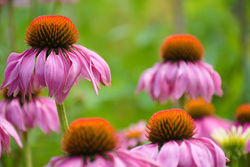The Chameleon Plant: A garden menace & how to eradicate it
- Lars Wildes
- Oct 11, 2023
- 4 min read
When it comes to maintaining a beautiful, thriving garden, battling invasive species is an unfortunate yet crucial aspect of the game. We should know... we just finished a battle with the Chameleon Plant, scientifically known as Houttuynia cordata.
Its vibrant foliage might initially deceive you, but make no mistake – this seemingly harmless plant can quickly become a garden's worst nightmare. And if you have been tricked, feel better knowing that we were, too. We'll explain how in the video below.
In this comprehensive guide and in the video, we'll delve into the world of Chameleon Plants, exploring the reasons to eradicate them and providing detailed steps to save your garden from this relentless invader.
Understanding the Chameleon Plant
The Chameleon Plant is an invasive herbaceous perennial that spreads aggressively through its rhizomes. Its heart-shaped, multicolored leaves may seem attractive at first, making it a popular choice for some gardeners. However, once introduced to your garden, this plant can grow rapidly, overtaking and choking out other vegetation.
Here's why it's important to remove it:
Competitive Growth: Chameleon Plants grow vigorously, outcompeting native species for sunlight, water, and nutrients. Your garden's native plants won't stand a chance in the presence of this invader after a few growing seasons.
Rhizomatous Nature: The Chameleon Plant spreads through underground rhizomes, which are challenging to eradicate. Neglecting them can lead to the plant's swift resurgence. And that's why it's important to dig deep enough around the plant and ensure that you've gotten the rhizomes out.
Disruption of Ecosystems: Invasive plants like Houttuynia cordata can disrupt local ecosystems by altering soil composition, reducing biodiversity, and making it challenging for indigenous species to thrive. While it's not officially invasive here in Denmark, we are still concerned about how fast it spreads and therefore decided to take it out of our garden.
How to eradicate the Chameleon Plant
Now that we understand the threat the Chameleon Plant poses, let's look at the steps required to remove it from your garden:
1. Identification
Start by identifying the Chameleon Plant. It has heart-shaped leaves with green, red, and yellow variegation, making it stand out. It's really pretty. But wait, don't be fooled.
2. Prepare Tools
Gather the necessary tools, including a digging fork, gardening gloves, a trowel, and a heavy-duty trash bag for disposal.
3. Timing
The best time to tackle Chameleon Plant removal is in early spring or fall when the plant is actively growing.
4. Digging and Removing Roots
Gently dig around the Chameleon Plant, ensuring you get as much of the root system as possible. Be thorough and patient in this step, as even a small portion left behind can lead to regrowth.
5. Remove Rhizomes
Carefully trace and remove the underground rhizomes to prevent the plant's resurgence. These may extend several feet from the main plant.
6. Proper Disposal
Dispose of the Chameleon Plant, including the roots and rhizomes, in a heavy-duty trash bag. Do not compost them, as they can survive and grow in compost.
7. Prevent Reinfestation
To prevent the return of the Chameleon Plant, consider mulching your garden beds, maintaining a healthy and diverse garden ecosystem, and staying vigilant for any regrowth.
Be prepared that it still may come back next year (if any rhizomes weren't removed). So be patient and keep at it. In a few seasons, your garden will finally be free.
Growing Chameleon Plants in pots and containers
If you've been captivated by the vibrant beauty of Chameleon Plants (we're guilty!) but are hesitant to introduce them to your garden due to their invasive nature, there's a solution that allows you to enjoy these eye-catching plants without the risk of them taking over your outdoor space.
Cultivating Chameleon Plants in pots can be a wonderful alternative that combines their striking appearance with garden control. Here's how you can do it:
1. Select Suitable Containers: Choose well-draining pots or containers with good-sized drainage holes at the bottom. This ensures excess water doesn't accumulate, which can be detrimental to Chameleon Plants.
2. Ideal Potting Mix: Use a high-quality potting mix with good moisture retention, ensuring the soil doesn't dry out too quickly. You can also add some organic matter to enhance fertility.
3. Planting: Carefully transplant young Chameleon Plants into your chosen containers. Be mindful of the roots and rhizomes as you transfer them.
4. Sunlight and Water: Place the potted Chameleon Plants in an area that receives partial to full shade. These plants prefer consistently moist soil, so regular watering is essential, but avoid waterlogging.
5. Maintenance: Keep a watchful eye on your potted Chameleon Plants to ensure they don't become root-bound. Repot as needed to allow for healthy growth.
6. Preventing Spread: By growing Chameleon Plants in pots, you significantly reduce the risk of their spreading throughout your garden. Since the rhizomes are contained within the pots, you won't have to worry about invasive takeovers.
Growing your Chameleon Plants in pots provides a great choice for those who appreciate their unique appearance but wish to avoid the headaches of managing their invasiveness in the garden. This allows you to enjoy the charm of Chameleon Plants while maintaining control over your outdoor space, all without compromising the health and biodiversity of your garden.





